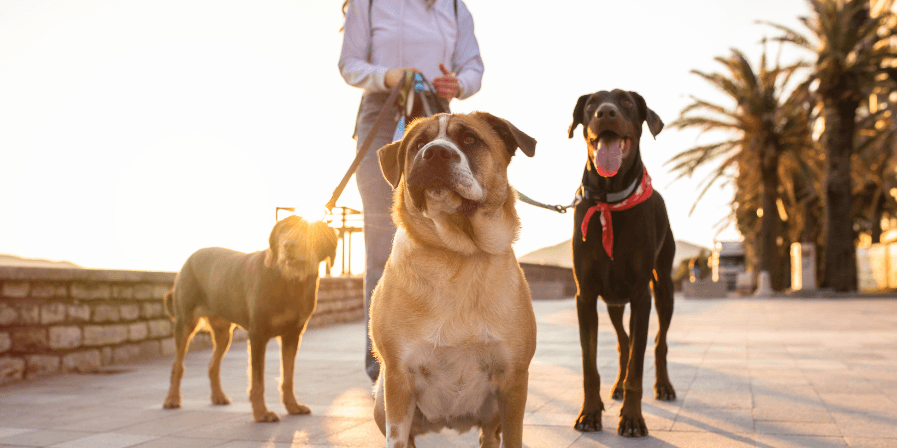Dog Exercising Tips for Warm Weather

When summer rolls in and the sun is high, getting outside with your dog can feel like the perfect way to spend the day. Long walks, playful runs, and park visits sound like a dream. But as much as our dogs love to be active, warm weather brings certain risks that every pet parent needs to consider. Heatstroke, burnt paws, and dehydration aren’t just possibilities—they’re real threats during the hotter months.
That said, exercise remains just as important in summer as in any other season. The key lies in how and when you do it. With the right adjustments, you can keep your dog fit, happy, and safe—even on the warmest days.
Let’s walk through some simple but essential ways to keep your dog moving while beating the summer heat.
Time Your Walks Wisely
When it comes to warm weather exercise, timing is everything. The sun is most intense between 10 a.m. and 4 p.m., and this is when outdoor temperatures—and the risk to your dog—skyrocket. Exercising during these peak hours isn’t just uncomfortable, it can be dangerous.
Instead, aim for early morning or late evening walks. During these cooler hours, the sun is lower, surfaces are less heated, and the air is more breathable for both you and your pup. Morning exercise can be particularly energizing, while evening walks help your dog wind down after a long, warm day.
You’ll notice a difference in your dog’s energy levels too—most dogs are more enthusiastic and less sluggish when they’re not battling the heat.
Never Leave Without Water
Just as you'd never go hiking or jogging without a water bottle in the summer, your dog shouldn’t either. Dogs can’t sweat the way humans do. Instead, they cool off through panting and limited sweating through their paw pads, which means they lose moisture quickly.
Always carry water when you're heading out for a walk or run. Bring a collapsible water bowl or a dog-friendly squeeze bottle and offer frequent breaks for hydration. Don’t wait until your dog is panting heavily—by that point, they may already be overheated or dehydrated.
And when you're back home, ensure they have access to fresh, cool water at all times. Some pet parents even toss in a few ice cubes to encourage drinking.
Be Mindful of Hot Surfaces
Here’s something we often forget—while we wear shoes, dogs don’t. Pavement, asphalt, sand, and even artificial turf can become dangerously hot under the summer sun. A surface that feels warm to your hand may be scalding to a dog’s paws. In fact, if it’s too hot for you to touch with the back of your hand for more than 5 seconds, it’s too hot for them.
Dogs who walk on hot pavement risk painful burns, blisters, and long-term damage to their sensitive paw pads.
Try walking your dog on grassy paths or shaded trails. If you're unsure, touch the ground first. You can also invest in protective dog booties if you must be out when surfaces are still warm. But ideally, schedule your outings when the sun isn't blazing and the ground is cool to the touch.
Consider Indoor Workouts
If it’s sweltering outside and even the shade feels heavy, it might be time to get creative indoors. Exercise doesn’t have to mean running laps outside—there are plenty of ways to keep your dog engaged, entertained, and active from the comfort of home.
You can play fetch in a hallway, set up a makeshift obstacle course, or work on obedience training that challenges your dog mentally and physically. Puzzle toys, tug-of-war, and treat-based games like "hide and seek" keep your dog’s mind sharp and body moving.
These activities may not provide the same cardio as an outdoor run, but they help reduce restlessness, prevent boredom, and burn energy in a safe environment.
Know Your Dog’s Heat Tolerance
Not all dogs are created equal when it comes to heat sensitivity. Brachycephalic breeds like Bulldogs, Pugs, Boxers, and Shih Tzus have short noses and compromised airways, making them especially vulnerable to overheating. Similarly, senior dogs, puppies, overweight pets, and those with certain medical conditions may struggle more in high temperatures.
These dogs may start panting heavily with even mild exertion in warm weather. If you have a heat-sensitive breed, their exercise routine needs to be handled with extra care. Stick to short, slow walks and cool environments. Don’t push them to keep up just because you want to squeeze in more activity.
Recognizing your dog’s physical limitations isn’t about doing less—it’s about doing what’s right for them.
Watch for Signs of Overheating
Even with all the precautions in place, it’s vital to know what trouble looks like. Dogs won’t always stop running or playing when they begin to overheat. In fact, some dogs will push through until they collapse—especially those who are naturally energetic or overly enthusiastic.
Keep an eye out for early signs of heat exhaustion: excessive panting, drooling, red or pale gums, weakness, vomiting, diarrhea, or sudden lethargy. If your dog seems confused, dizzy, or collapses, it's a medical emergency.
If you suspect heatstroke, bring your dog into a shaded or air-conditioned space immediately. Offer cool (not cold) water and use a damp cloth or towel to cool their body—focusing on the belly, underarms, and paw pads. Then call your veterinarian right away.
Help Them Cool Down After Exercise
Even if the walk was short and the weather mild, your dog still needs help cooling down—especially after running or playing.
Once back home, guide them to a shaded area or an air-conditioned room. Offer fresh water and a comfy spot to rest. Many dogs love to sprawl on cool tile floors or enjoy a fan blowing near their bed. You can also provide a cooling mat or freeze a toy for them to chew on.
Some dogs enjoy a splash in a kiddie pool or a gentle rinse with lukewarm water (not ice-cold) to refresh their bodies. If you have a backyard sprinkler, it can double as fun and relief.
Just like you need time to recover after a workout, so does your dog—especially when it’s warm outside.
Conclusion
Keeping your dog active during warm weather doesn’t have to feel like a challenge. With just a few thoughtful changes to your routine, you can ensure your pet stays healthy, happy, and safe all summer long. Remember, exercise should never come at the cost of your dog’s comfort or well-being.
And if you ever find yourself second-guessing whether it’s too hot, it probably is. Trust your instincts, listen to your dog, and always prioritize their health over hitting a daily step goal.
If you ever have questions about your dog’s fitness needs in warm weather, heat sensitivity, or hydration levels, don’t hesitate to reach out to a veterinarian. At DCC Animal Hospital, our team is always here to guide you with personalized care and practical advice, helping your dog thrive all year long.
FAQs
1. How can I tell if it’s too hot to walk my dog?
A good rule of thumb is the “five-second test.” If the pavement is too hot for you to hold your hand on comfortably for five seconds, it’s too hot for your dog’s paws. Also, consider the humidity and overall heat index—it may be safer to wait until early morning or evening.
2. Is it okay to skip walks on extremely hot days?
Yes, absolutely. On dangerously hot days, it’s better to focus on indoor play and mental stimulation. Skipping a walk is far safer than risking heatstroke. Rotate in puzzle toys, treat games, or obedience training to keep your dog engaged.


 How can we help?
How can we help?